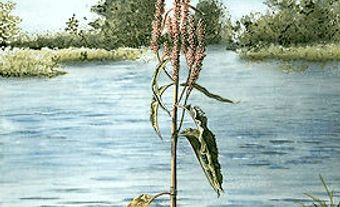
Yarrow
Yarrow, common name for some 200 species of herbaceous plants of genus Achillea of the Compositae (Asteraceae) family; 3 species occur in Canada (Achillea millefolium, A. ptarmica, A. sibirica). Common yarrow (A. millefolium var. lanulosa), also known as milfoil, is an erect, aromatic perennial with rhizomes (underground stems). It grows across Canada in grassy places and roadsides from BC to Nfld, N to Great Bear Lk. The genus was named for the Gk hero, Achilles, who was supposed to have used the plant to heal his soldiers' wounds. Lanulosa comes from Lat lana, "wool." The leaves grow alternately up the densely hairy, 30-100 cm stem and are finely divided with a feathery appearance [Lat millefolium, "thousand leaf"]. Flowers, borne in flat clusters of numerous flowerheads, are composite structures.
Yellowish disc florets (3-10) make up the central part, which is surrounded by 5 petal-shaped ray florets. They bloom from May to October. Yarrow has a dry, one-seeded fruit. Throughout the ages, yarrow has been used to stop blood flow, hence one common name, "nosebleed." Blackfoot used it to aid childbirth, for gastroenteritis and liver trouble, as a diuretic, and for sore throat and skin troubles. A. ptarmica (sneezeweed) occurs across Canada, from southern BC to PEI. A. sibirica is found from the YT to eastern Québec, including central BC. See also Plants, Native Uses.

 Share on Facebook
Share on Facebook Share on X
Share on X Share by Email
Share by Email Share on Google Classroom
Share on Google Classroom


